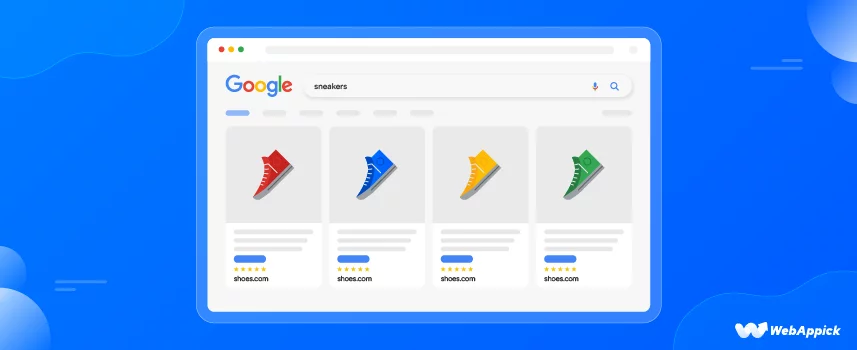
A Complete Guide to Organic Listing on Google Shopping
Organic listing on Google Shopping allows eCommerce businesses to showcase their products in Google Shopping results without paying for ads.
By optimizing product titles, descriptions, images, and structured data in your Merchant Center account, you can improve visibility, attract qualified traffic, and boost sales naturally.
Are you struggling with your WooCommerce store with no traffic/conversions/sales?
Don’t have the funds to run expensive ad campaigns for your new WooCommerce store?
Well, the Google Shopping engine can be the white knight for your WooCommerce business!
Your product’s organic listing on Google Shopping can drive loads of potential traffic/customers to your online shop. As these customers already intend to buy, you can get a significant amount of sales from this channel if done right.
Most importantly, organic listing on Google Shopping is absolutely free.
But how do you do it?
? We will cover all the details and provide a step-by-step guide for you to display your WooCommerce products across Google platforms, including Google Shopping, in this article.
So hop on, and let’s get started.
What is Google Shopping?
In simple words, Google Shopping, formerly known as Google Product Search, Google Products, and Froogle, is the place where the search giant displays eCommerce product search results.
It is a price comparison shopping engine that allows customers to compare the prices of the same product from different retailers.
WooCommerce store owners like you can list your products in the Google shopping engine. You can also run advertisements/paid Google Shopping ads on Google Shopping search result pages.
When a customer searches for a product in Google Shopping, it gathers all relevant products listed by different retailers like you and displays them in a side-by-side grid view on a single page.
The customer then can compare the price and features without visiting individual store websites and ultimately decide to buy from the retailer that offers the best value.
Google Shopping is now available as a regular tab on the search result pages. However, users can only see this tab when they search for an eCommerce product.
Nonetheless, visitors can visit the Google Shopping site by typing its dedicated URL.
How Google Shopping works
Let’s check how Google Shopping displays your products.
For instance, suppose a customer is looking to buy a smartwatch. The first thing he does is Google it to learn about different models, features, and, of course, prices.
When a customer types in “smartwatch” in Google, it returns something similar to this –
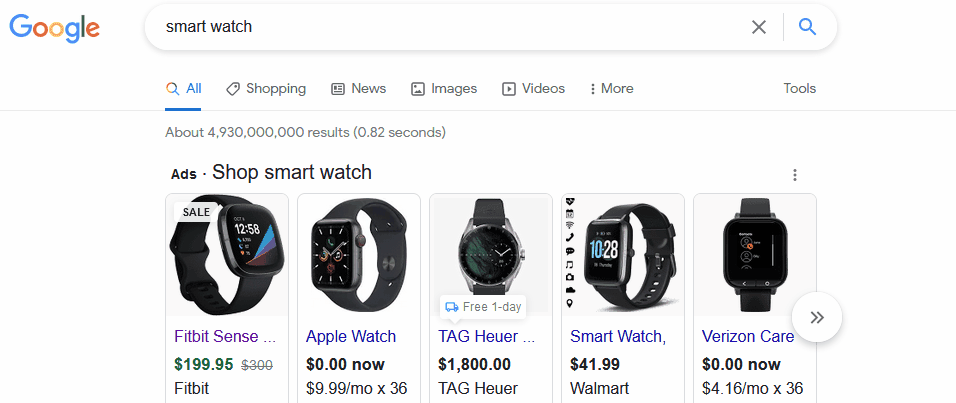
As you can see, the regular result page displays some product ads at the top from retailers like you running shopping ads in the Google Shopping campaign.
Along with that, it also shows regular website links and Google’s new Top 24 section, but where we are looking to go is the Shopping tab at the top.
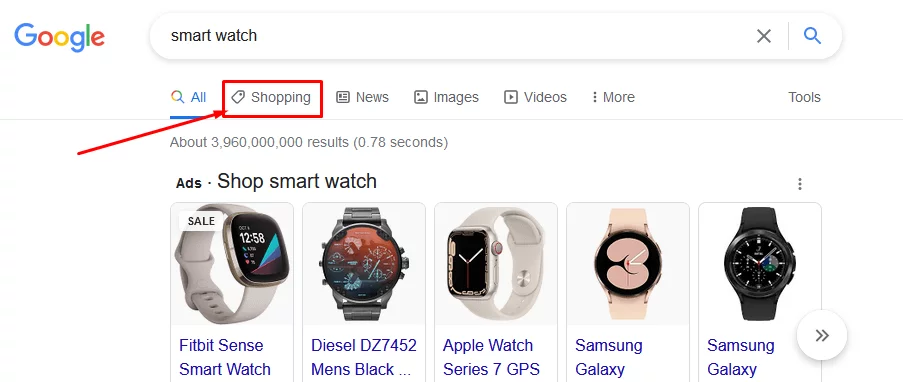
Alternatively, users can type in shopping.google.com to visit the site directly and search for products.
Let’s look at how Google Shopping SERP(search engine result page) looks with our particular “smartwatch” search.

As can be seen above, Google displays the paid promotions at the top and then shows regular or Google Shopping free listings.
Users can filter their search from the left panel by attributes such as price range, color, size, weight, etc. When a user clicks on your particular entry/listing, a window will pop up with your product’s gallery images and important details.
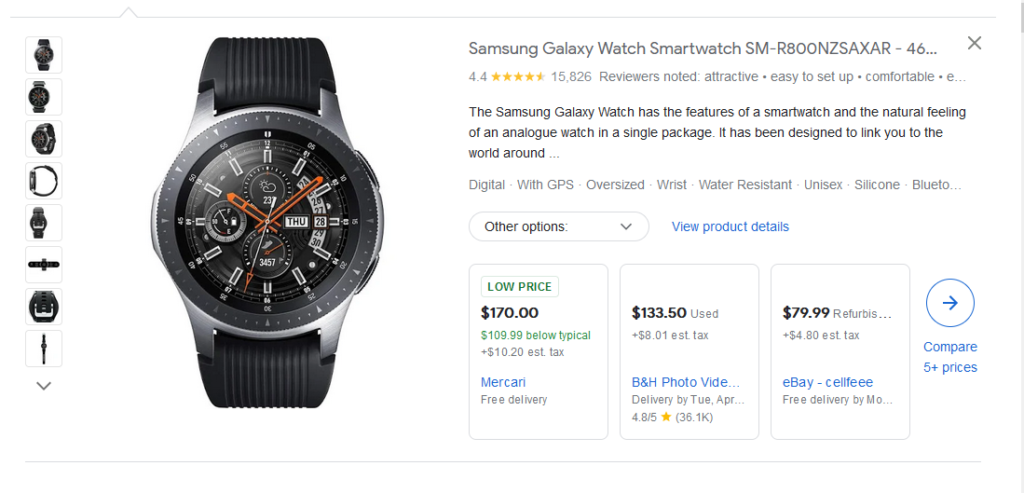
Visitors can either click the title and visit your store’s page or click product details to visit Google Shopping’s product details page for that product. On the product details page, Google displays full details and features of the product along with user reviews.
Additionally, you can let your visitors buy directly from Google if you join the Buy on Google option in the Google Merchant Center. However, this is available only in the US.
What is an organic listing on Google Shopping?
Google Shopping has been around for a while, but it was limited to only paid product ads/listings.
Due to the COVID-19 pandemic, many brick-and-mortar stores went out of business, and the overall retail businesses were affected.
To address the crisis situation and help the struggling retailers, Google launched an organic listing on Google Shopping.
This means WooCommerce store owners like you, along with other eCommerce merchants and even local shop owners, can list their products in Google Shopping for free.
This opens up a whole new door of opportunities for retailers like you.
At least 22% of people seek Google’s help when searching for a product to buy. With free product listings Google, you can reach potential customers who are looking to buy your products and drive an incredible amount of traffic to your store that can end up in sales, all for free.
Types of Google Shopping free listings
Google Shopping allows you to create two types of organic/free listings.
- Enhanced listings
- Standard listings

Each free listing type has its own set of requirements and is displayed differently across Google platforms.
Let’s have a look.
| Enhanced listings | Standard listings |
| Requires more quality data and product attributes. | Requires fewer product data attributes. |
| Retailers can submit product data only in Merchant Center. | Retailers can submit product data in two ways. Merchant Center or via structured data markup. |
| Your Google Shopping free listings will appear on more Google platforms such as the Shopping tab, YouTube, Google Search, Google Images, Google Lens, etc. | Your products will be displayed across Google Search, Google Images, Google Lens, etc. |
We will learn about product data feed and attributes and how to upload them to Google Shopping later in the article, but first, let’s check what attributes you need to provide to list your products on Google Shopping.
Product Attributes required for Enhanced listings
- Description [description]
- Availability [availability]
- Condition [condition]
- Brand [brand]
- Gtin [gtin]
- Mpn [mpn]
- Multipack [multipack]
- Bundle [is_bundle]
- Color [color]
- Size [size]
- Age group [age_group]
- Gender [gender]
- Item group ID [item_group_id]
- Shipping [shipping]
- Tax [tax]
- Pattern [pattern]
- Material [material]
- Additional image link [additional_image_link]
- Condition [condition]
- Size type [size_type] & Size system [size_system]
- Link in Google Search Index [canonical_link]
Product Attributes required for Standard listings
- Id [id]
- Title [title]
- Link [link]
- Image link [image_link]
- Price [price]
How does Google show your organic listings?
We have already mentioned different platforms, such as the Shopping tab, Google images, YouTube, etc., where Google displays your free/organic listings through the Enhanced listings. Let’s dig a little deeper to learn how Google shows your products on these pages.
The Shopping tab (shopping.google.com)
We have already seen how Google displays your products in the Google Shopping tab. You can display your products in the Shopping tab only through the Enhanced listings. Your products can be accessed from desktop and mobile devices. However, your products can only be seen in the countries where the Shopping tab is available.
Google also allows organic listings of local store’s products. If you sell on multichannel, for instance, if you have a brick-and-mortar store along with your WooCommerce store, you can list your local products in the Google Shopping tab. You can include store hours, directions, phone number, store address, product price, product availability, etc.
When you list your local products in the Google Shopping free listings, it will let your customers know that a nearby retail store is available where they can find the product they are looking for.
You can also enable the Buy on Google option if you are from the US.
Google SERP (Google.com)
Google search engine result page displays your organic listings in three ways.
1. Rich results
When customers s use Google Search to learn about products, retailers, and brands, rich results may appear alongside the search result.
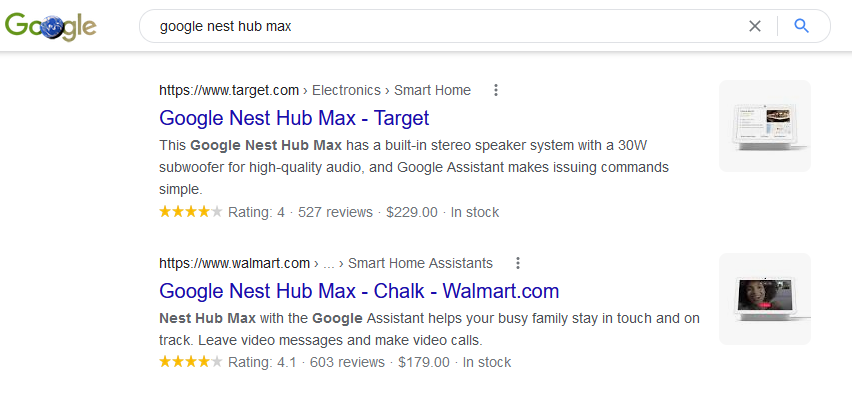
It appears as a few lines of text with additional useful product information such as price, availability, customer ratings, etc.
Google displays rich results globally. Therefore, your organic listings can appear in any country and on any device (Desktop or mobile).
2. Popular Products (apparel and accessories)
If you are in the apparel and accessories niche, sell cloth, bags, caps, shoes, etc., your Google Shopping free listings can be eligible to show in the Popular products section. This section shows customers the popular products and related categories and attributes relevant to their search.
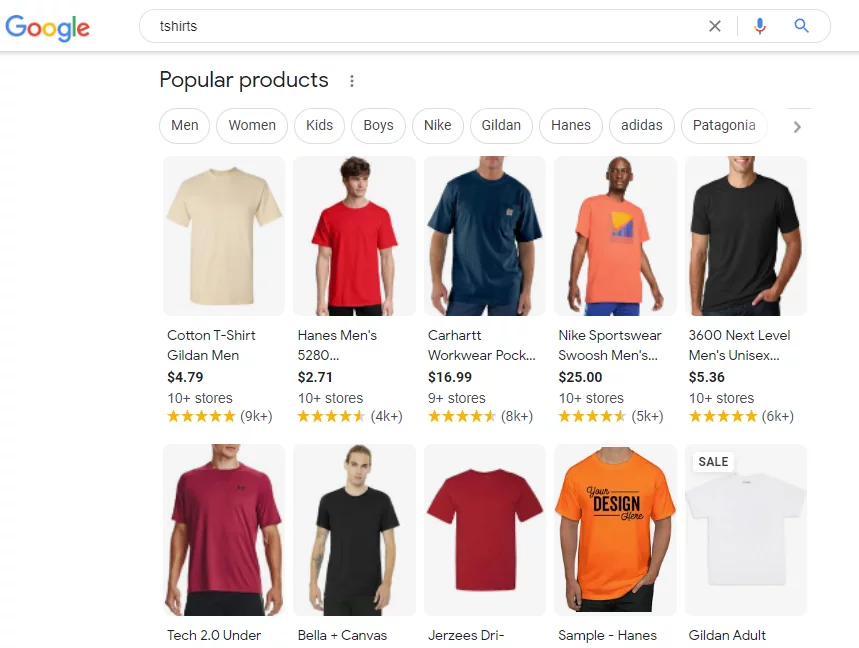
When a user clicks on any product, a window at the right will pop up, which shows product details, reviews, and different retailers like you offering the product. This pop-up window is also known as the knowledge panel.
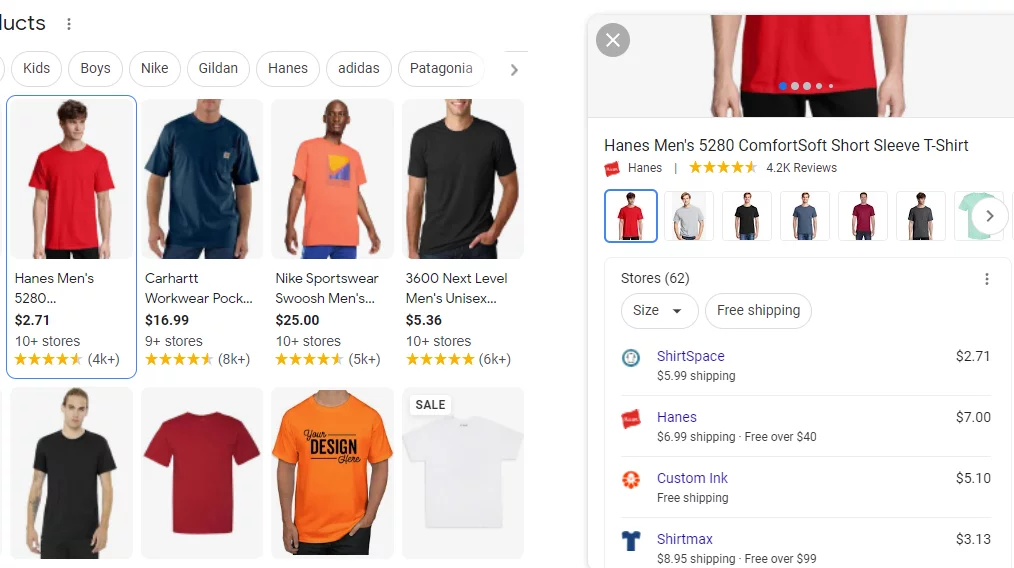
3. Top 24
This is a newcomer to Google’s product display sections. The Top 24 is a category-specific section. It will only appear when users search for a product category. For example, when a user searches for a “smartwatch” the top 24 section will appear on the search result page.
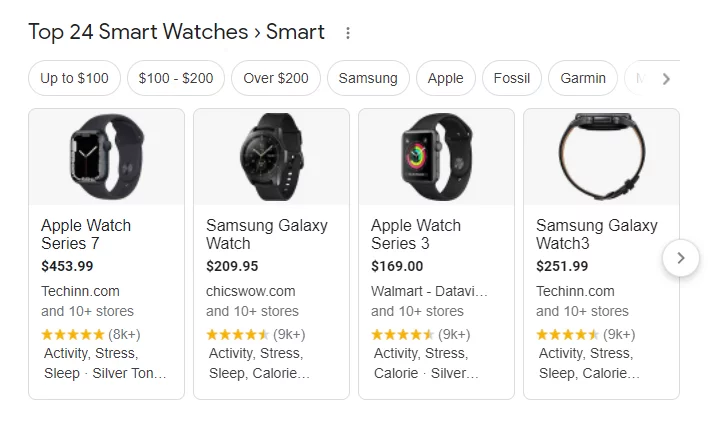
But if they search for a specific product, for example, “apple smartwatch,” this section won’t show up. Similar to the Popular products section, the Top 24 section lets users filter their search by different attributes, and a knowledge panel pop-up window will appear on click.
However, unlike the Popular products section, the Top 24 section is not limited to any specific niche or category. Therefore, your product’s free listings can appear in this section no matter what niche your WooCommerce store is on.
Google Images
Your Google shopping free listings can appear in Google’s image search. Google displays a product badge/label on the images that have a product linked to them.
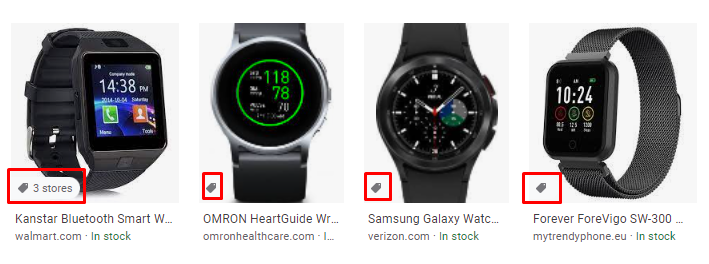
This label indicates to the customers that they can buy this product by visiting the image link. Additionally, users can also use the Google Lens feature to find similar products from image searches.
If your product images are unique and of high quality, there’s a high chance Google will display your organic listing images at the top, and you will receive a fair amount of traffic from this site.
YouTube
Your organic listings can appear underneath YouTube videos. Also, if a user searches for a relevant product on YouTube, your free listings can appear in their search result. However, this is a mobile-only feature and limited to specific countries.
Difference between Google free product listings and paid listings
| Paid listings | Organic/free listings |
| Not limited to any location, platform, or category | Have some limitations and country/platform restrictions |
| Always appears at the top of any platform or page | Appears below the paid listings |
| Low competition | Very high competition |
| Expensive | Completely free |
| Some people always ignore/dismiss ads | Cannot be closed/dismissed |
| Not completely reliant on organic method for ranking | Dependent on organic methods to rank high |
| Advance skills needed to run a campaign | Easy to follow steps to add product data |
How to list your products on Google shopping for free?
You must follow these two steps to add your products to your organic listing on Google Shopping.
- Create a Product feed file.
- Set up a Google Merchant Center account and activate product listings.
Let us explain these steps one by one.
Create a product feed file
A product feed file contains all the information of your products, such as name, price, category, brand, stock, shipping, etc. You can upload this file to any channel you sell your products on, such as Google Shopping, Etsy, Walmart, etc.
A product feed file can save you an incredible amount of time and effort. It saves you from going to every channel and creating products individually. You can quickly create product feed files in your WooCommerce store and upload them to all your channels.
However, WooCommerce doesn’t have a built-in product feed exporter. But a free plugin called CTX Feed can do the job effortlessly. Not just Google Shopping, it can create a product feed file for more than 100 channels.
Moreover, when you make any changes in your product’s information in your WooCommerce store, you can update the product feed files you created using the CTX Feed plugin, and all your changes will be updated automatically across your channels.
For instance, if you have changed the price or other information of some products in your WooCommerce store, you can go to your feed file list in the CTX Feed plugin and update the Google Shopping feed. And the information will be automatically updated in Google shopping free listings through the product feed file. Isn’t that awesome.
Creating a product feed file with the CTX Feed plugin
Let’s quickly check how to create a product feed file for your organic listing on Google shopping using the CTX Feed plugin.
First, install the plugin from the WordPress repository. After installing it, you will see a new CTX Feed menu on your left panel. Click on Make Feed.
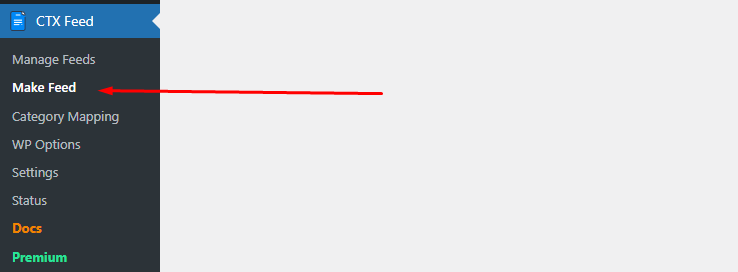
Now, specify your country, give your file a name and choose your file format. From Template, select your channel, which in our case is Google Shopping.
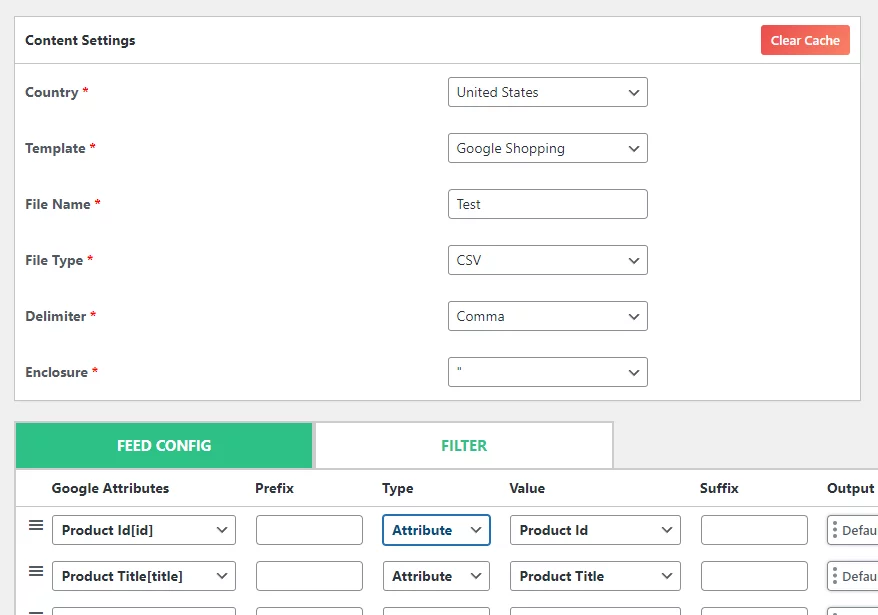
The plugin will automatically fetch all product information from your Woo store and populate Google attributes. However, you can customize or make changes as per your need. Once you are done, you can click on the Generate Feed button.
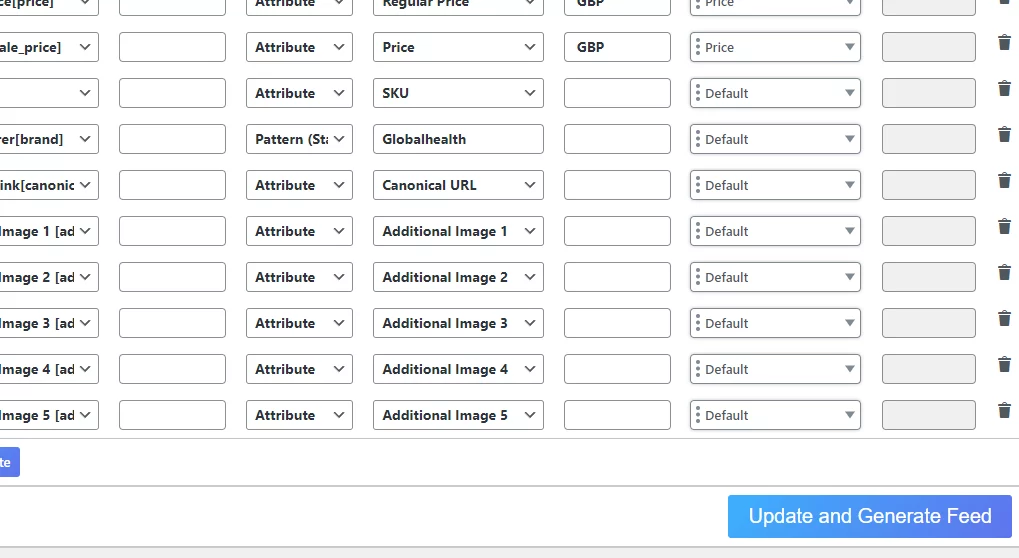
The next task is to set up a Google Merchant Center and upload our product feed file.
Set up a Google Merchant Center account
To show your products in free product listings on the Google Shopping engine, you need to set up a Google Merchant Center account first.
But is Google Merchant Center free?
Yes, if you have a Gmail account, you can sign up and access Google Merchant Center at any time. After you log in, you need to go to the Growth menu and click on Manage programs. You will see a section called Free Product Listings formerly known as Surfaces Across Google. You can click on Get Started to start the process.
However, if you are entirely new to Google Merchant Center and signing up for the first time, it will prompt you to jump directly to the process of creating Google Shopping organic listings of your products.
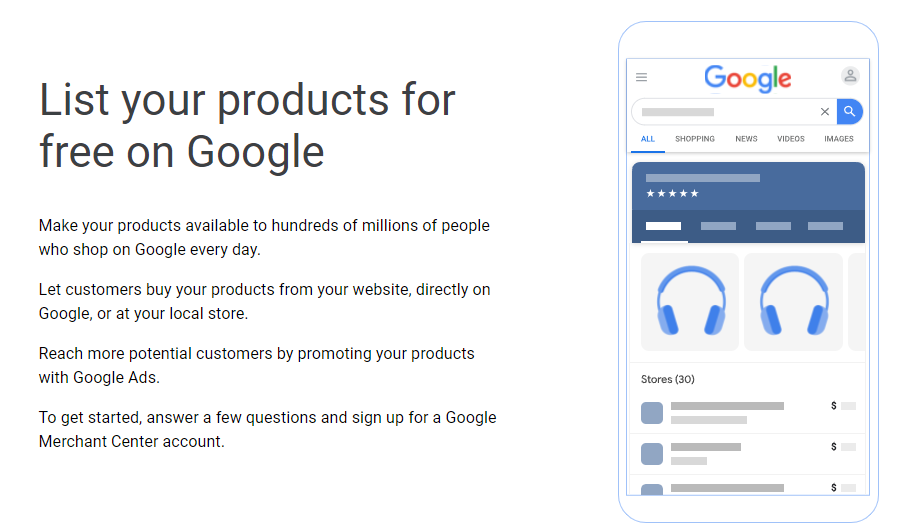
Let’s set up Google shopping free listings from a new account. Scroll down the signup page and fill in the information—first, your business name and location.
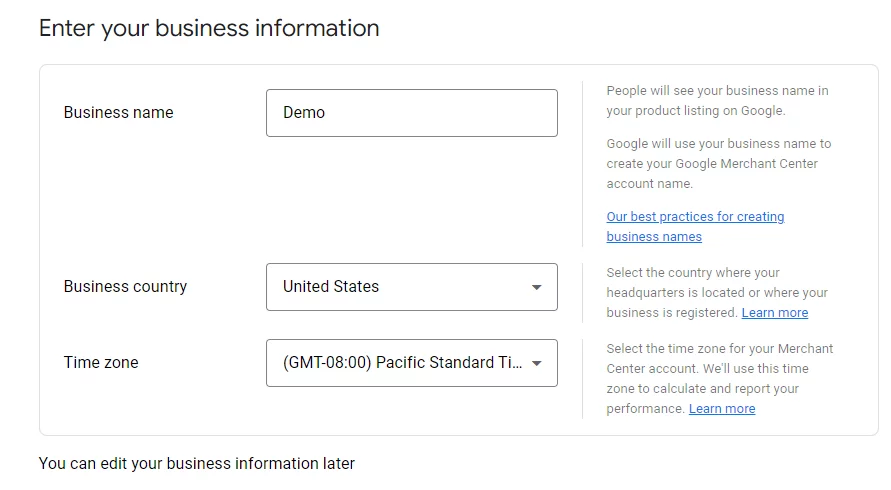
Then you need to specify where your customers will checkout.

You can allow the free listings to lead them to your website or pay inside Google. We have talked about the Buy in Google in previous sections. You can also lead your customers to your brick-and-mortar store through your Google Shopping organic listings.
Next, let Google know what platform your store is at, in our case WooCommerce. You can subscribe to their mail list and finally agree to their terms and click on Create Account.
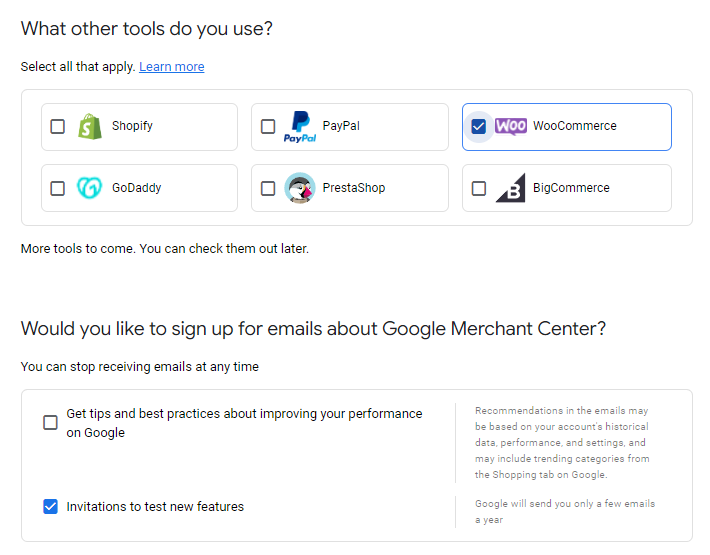
That will create your new Google Merchant Center account. Now continue to the next window to input your details, upload your product feed and finish setting up Google free product listings.
Setting up the organic listing on google shopping
In order to show your products in free product listings on the Google Shopping engine, you need to fulfill the following checklist shown in the image below.
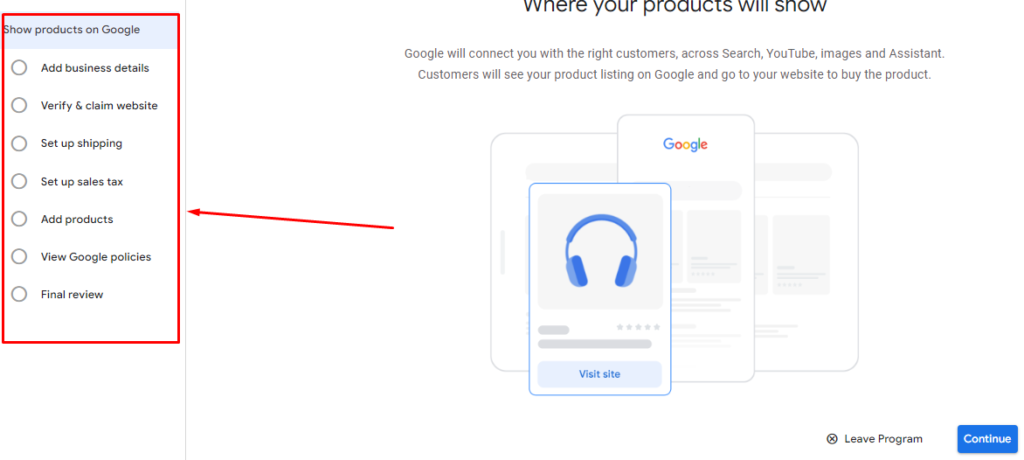
First up, your business address. Write down your business address and click Save to continue. You can also verify your phone number to confirm you are the owner of the business.
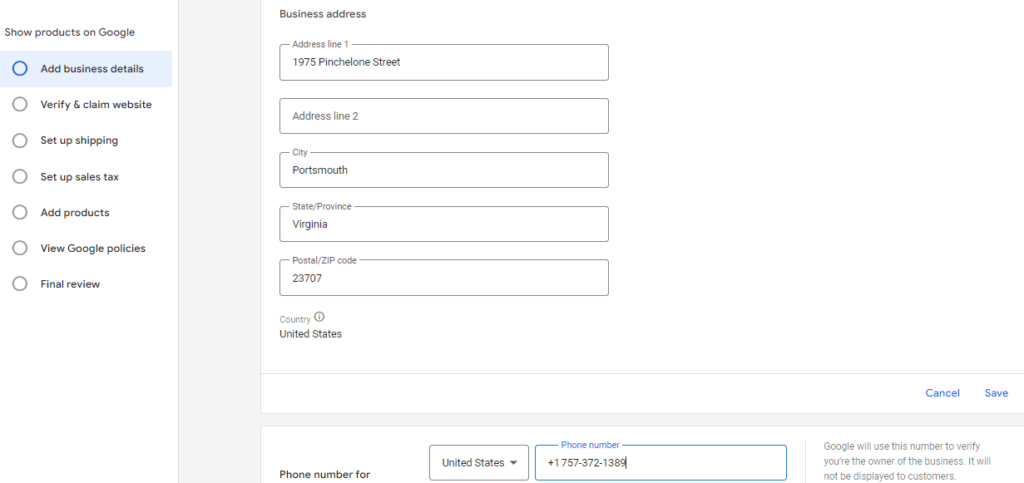
In the second step, we need to verify our WooCommerce store. Put your website URL and continue.
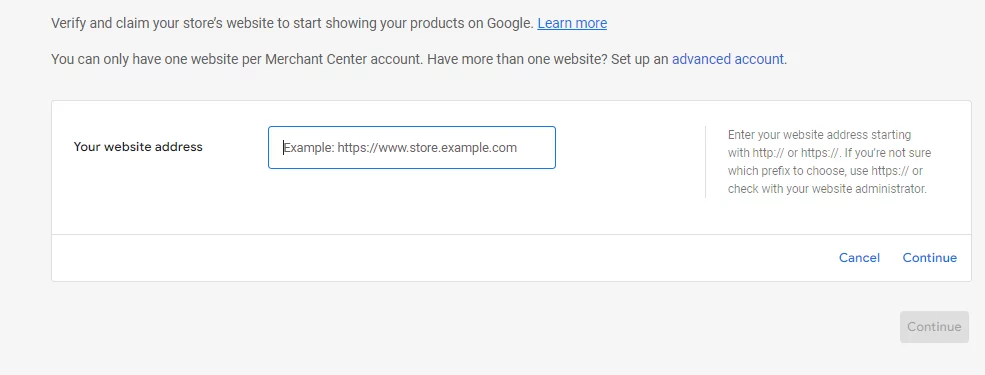
Now we need to do some technical stuff. To verify your website, you have two options.
- Add HTML tag
- Upload an HTML file
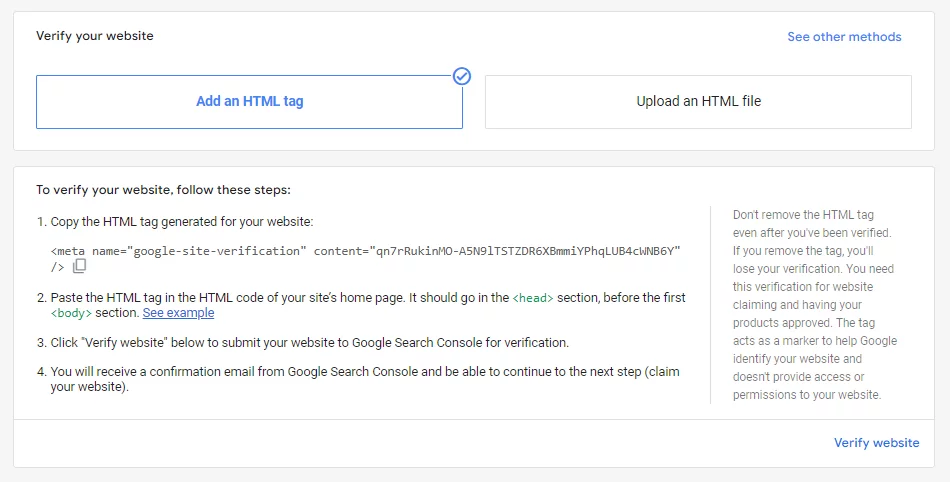
Adding an HTML tag to your WooCommerce website is a bit technical for ordinary users. However, popular themes such as Divi come with settings where you can add HTML tags without accessing the theme file editor. You can also find plugins that offer to add codes and tags without accessing the raw files.
If you have access to your web server control panel, you can upload an HTML file instead of adding any code.
Once your website is verified, this screen will appear.
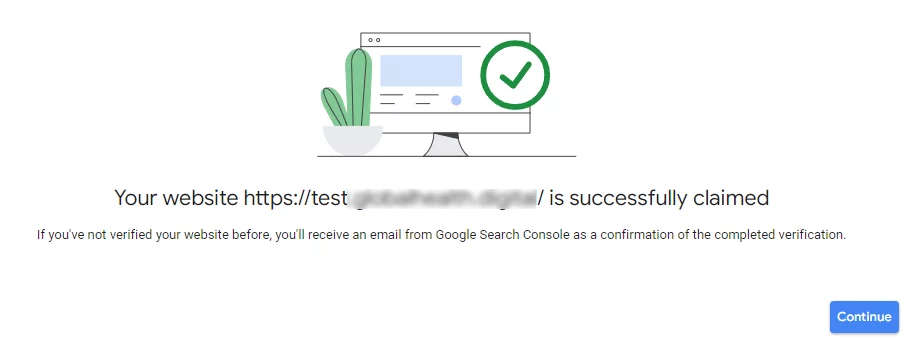
In the next few processes, you need to fill up your shipping and sales tax information. Then you will have to upload the product feed file you created in the CTX Feed plugin.
Uploading product feed file to Google Shopping
Select the Add multiple products at once option to start the process of uploading the product data feed.
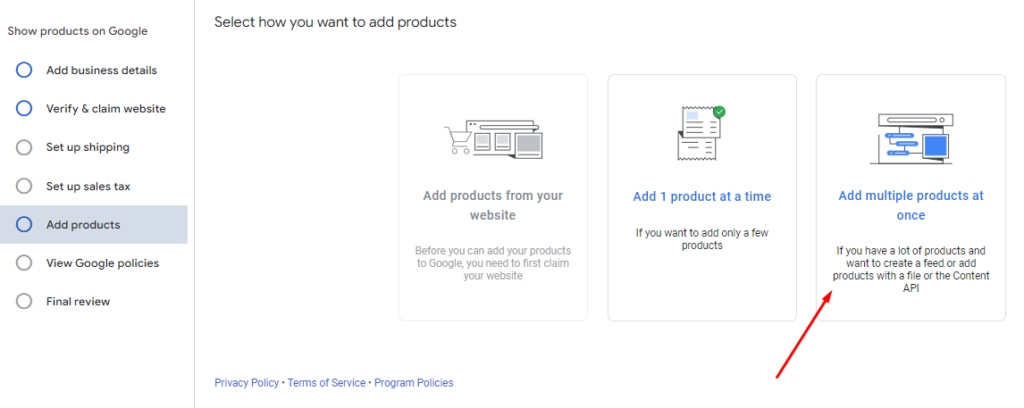
Select your country of sale and language and continue.
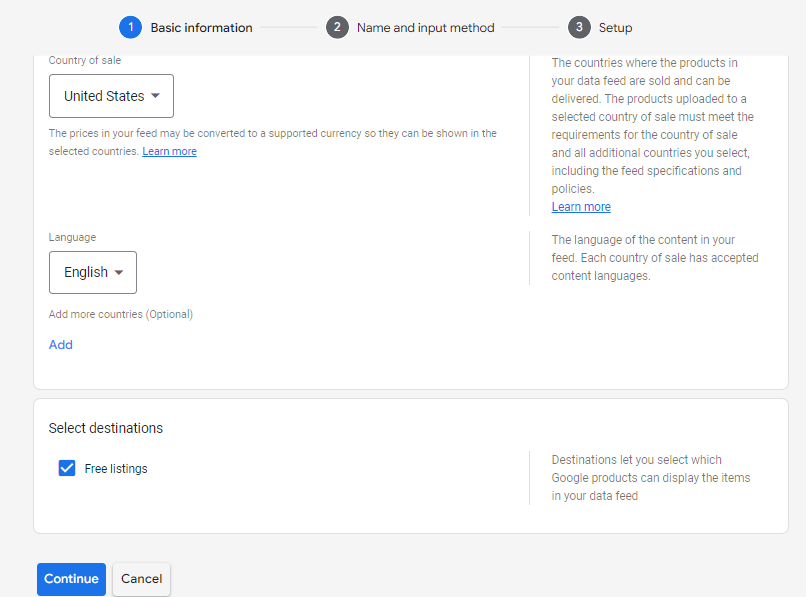
Give your feed a name and select the Scheduled fetch option to continue.
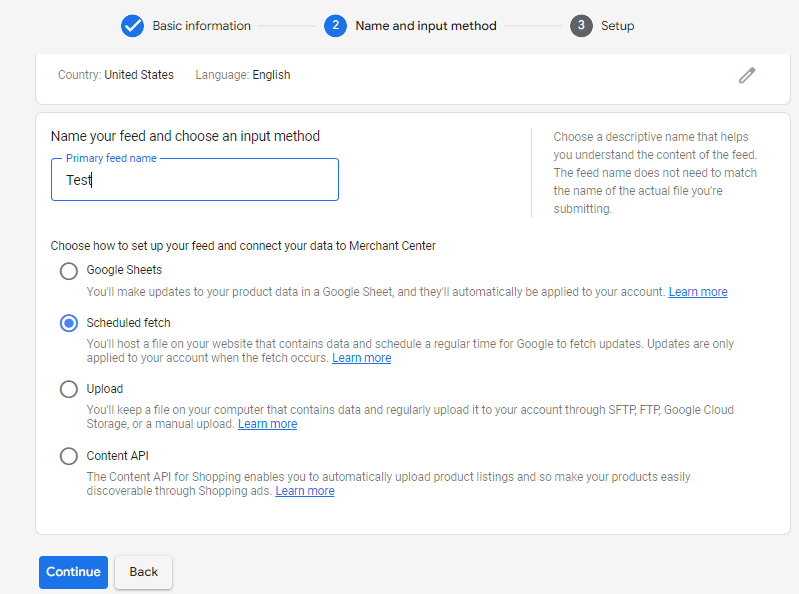
Now you need to enter the product feed file name you created inside your WooCommerce site using the CTX Feed plugin.
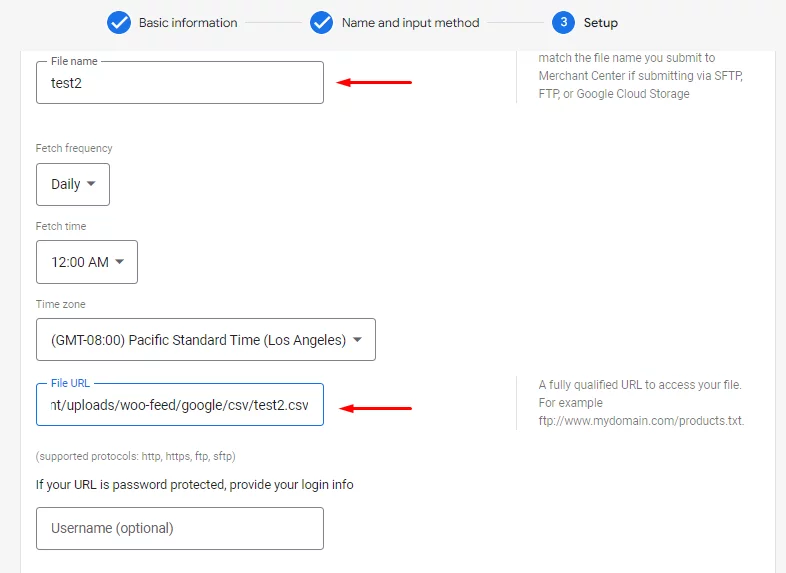
Copy the product feed file URL from your WooCommerce back panel and paste it into the File URL box in the Merchant Center.
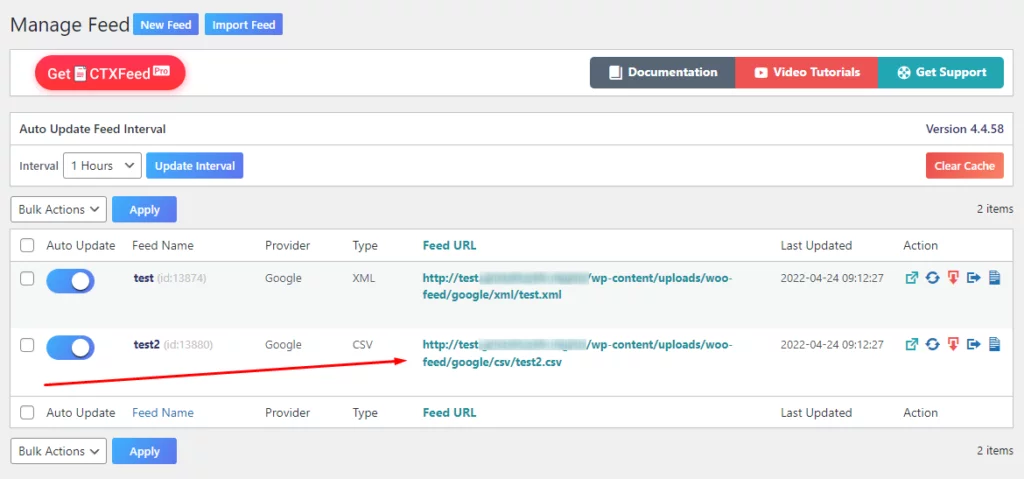
When you are done, click the Create Feed button, and Google will connect your feed to Google Shopping. You can click the Fetch Now button to immediately upload your product details to the Merchant Center.
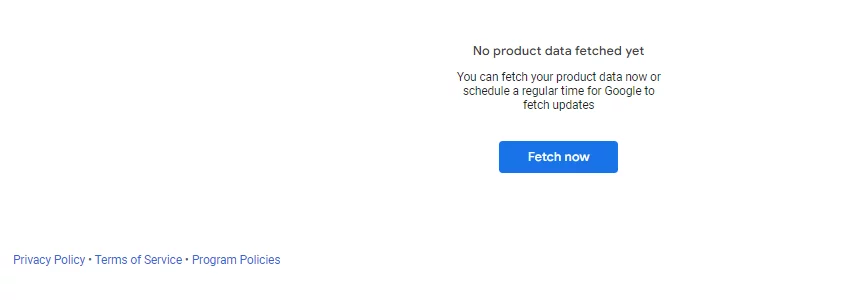
It will take some time for Google Merchant Center to fetch all your product details, depending on the number of products you are uploading. After the upload process is over, all your products will be visible in the Merchant Center.
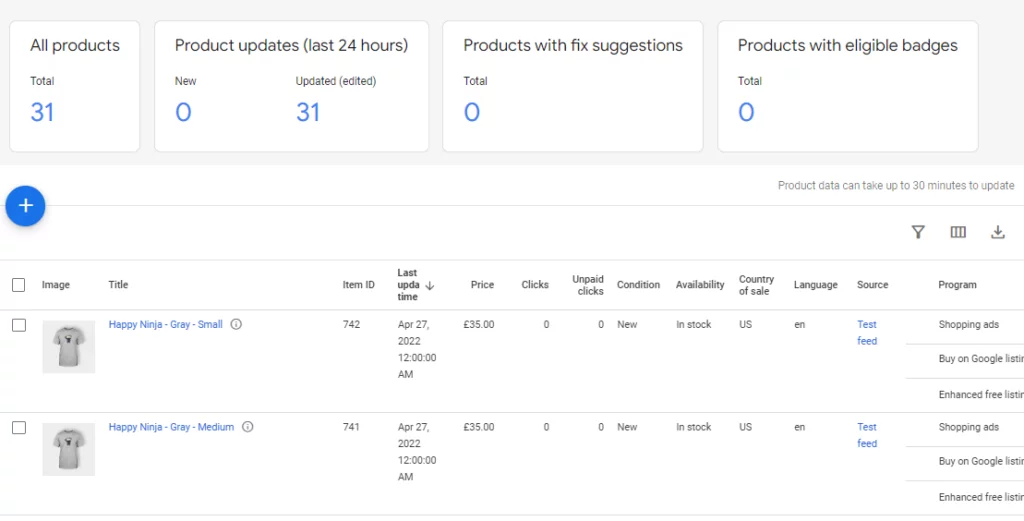
You can also edit any product details from your Merchant Center account. Once you finish all the steps, Google will review your submitted data before they list your products in the Google shopping free listings.
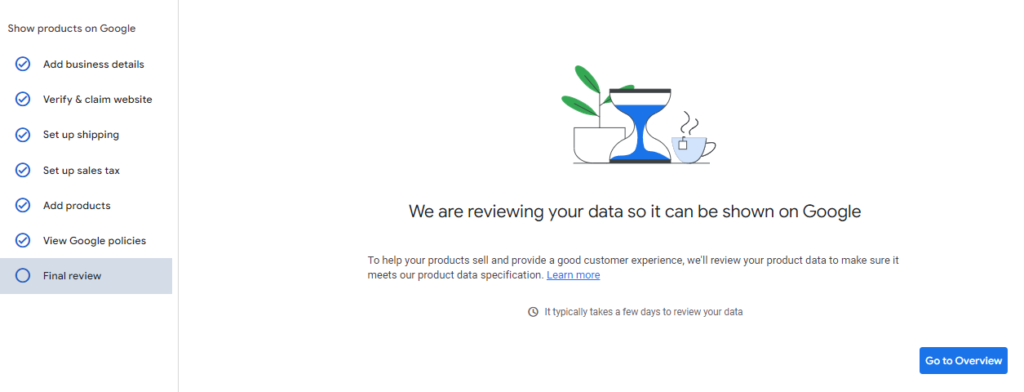
That’s all on your part to do to display your products in organic listing on google shopping.
How to optimize organic listing on Google Shopping?
So you have added your products to the organic listing on Google Shopping program, and Google is displaying your free listings. Hence, you can expect to receive plenty of visitors to your WooCommerce store, right?
But what about your competitors, and why will Google prefer your free listings over your competitors? That’s where SEO comes into play. You need to optimize your free listings in order to stand out and rank high on Google Shopping.
SEO optimization for Google Shopping free listings is almost similar to Google Ads or WooCommerce store’s SEO.
You can do it manually and optimize your added Google Shopping organic listings one by one. However, that will eat up a lot of time and effort.
The best way to optimize your Google Shopping free listings is to do SEO in your WooCommerce store and use a product feed plugin like the one we have used, the CTX Feed.
When you SEO optimize your products in your WooCommerce store, CTX Feed will fetch those optimizations as well and upload them to Google Shopping. The better you optimize your products, the higher they will be displayed in Google Shopping search results.
But what and how should you optimize? Just like regular best SEO practices, you need to optimize your product title, description, image, etc., in order to be displayed at the top of Google Shopping organic listings.
Title
The title is probably the most important part that needs to be optimized for your organic listing on Google Shopping. Your product’s title is the first thing people will see, and it needs to be relevant to their search.
Google determines a listing’s relevance to a search through keywords. You need to research keywords and apply the best ones in your title to appear in your target audience’s searches. However, don’t stuff your title with a lot of keywords.
Additionally, you should include essential attributes such as product type, color, brands, gender, etc.
Product description
Make sure you include your target keywords in your product description properly. Moreover, ensure that your product description is specific, accurate, and engaging to the readers.
Product image
Product images are one of the most essential parts of any WooCommerce store. A product image can make or break a sale. The better the images are, the more they attract your customers.
Make sure you put high resolution, clear and attractive images for all your products. If you have a product gallery for any product, Google Shopping also fetches that gallery from your product feed and displays it in the free listings.
Therefore, include as many images as you can to better explain the features of your product and show different angles of it.
Product specifications/features
People use product features/specifications in their searches. Ensure you put all appropriate product features and specifications in your organic listing on Google Shopping. As a result, more of your product listings will be seen by the people who matter.
Product category
It is very crucial that you pick the right categories to reach your target search audience. You can define the correct Google product category from CTX Feed attributes list when creating a feed in your WooCommerce back panel.

Frequently Asked Questions (FAQs):
Google is allowing eCommerce shop owners as well as local store owners around the world to list their products on the Google Shopping platform for free. These are called Google Shopping organic listings or Google Shopping free listings.
You need two things: a Google Merchant Center account and a product feed file. You need to create a Google Merchant Center account, submit the necessary details and upload your product feed file for Google to review. After reviewing, Google will display your products on different platforms, including Google Shopping.
Standard WooCommerce doesn’t have any tool to create a product feed file. However, there’s an awesome plugin called CTX Feed that can do the job effortlessly. You can create a product feed file with SEO-optimized data from your WooCommerce store using this plugin and also can update your product data across all your channels automatically.
Wrap up
Google Shopping free listings are a fantastic opportunity for all WooCommerce store owners. It gives them the opportunity to promote their products to a massive audience for free.
Moreover, it allows them to drive a significant amount of free traffic to their store who already have decided to buy.
You can also step up your game by running paid Google shopping ads along with your organic listing on Google Shopping. It will bring more leads to your store and convert more visitors into buyers.
We hope this guide on Google Shopping organic listings will help you get started on adding your own products to the shopping engine and utilize the opportunities it offers.
You May Also Like

I loved this article. Thank you!
Can you please tell me how you would check that your products are actually being listed on the search pages
Hi,
If an item gets approved on GMC, it means it’s listed.
Thank you,